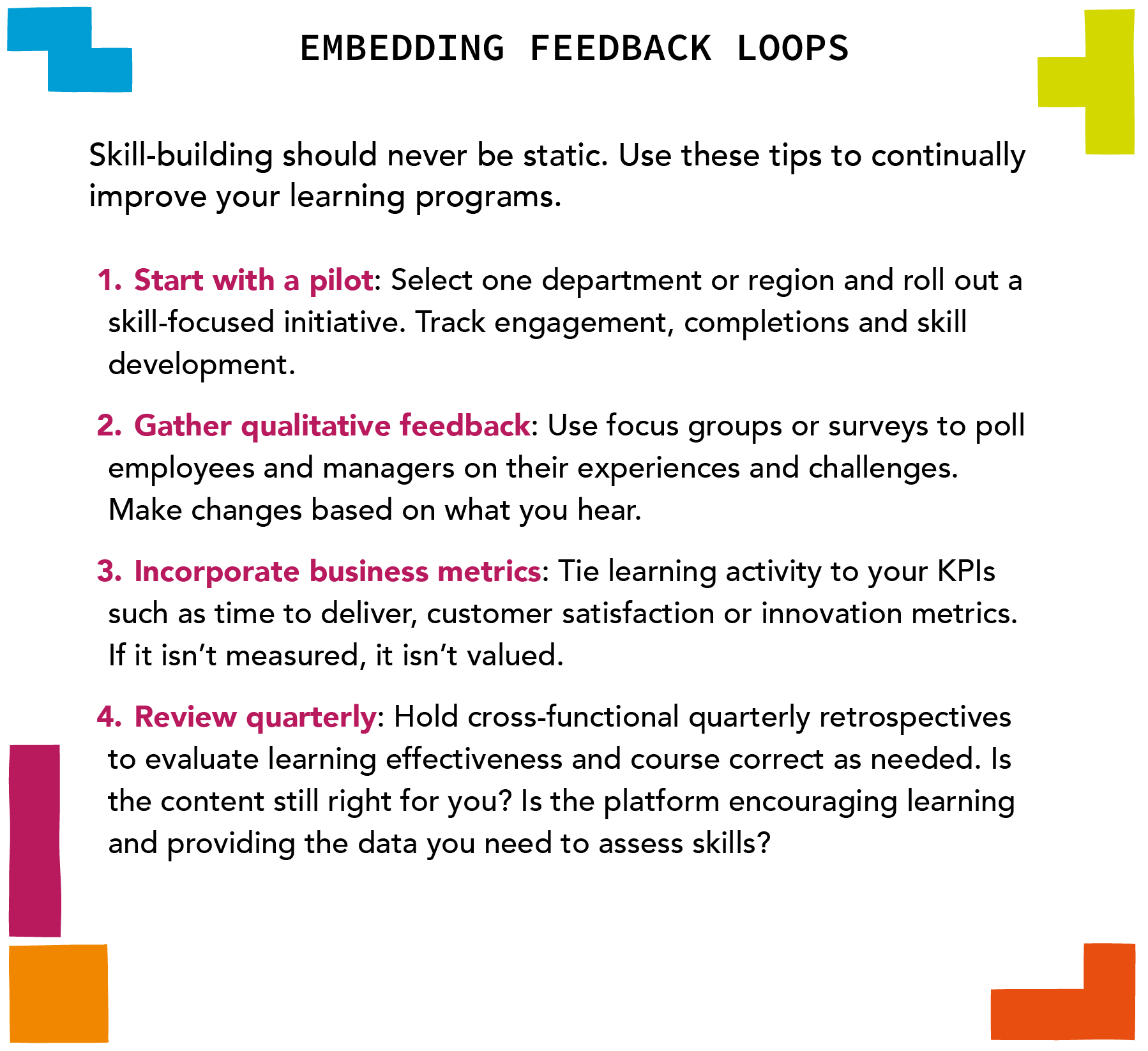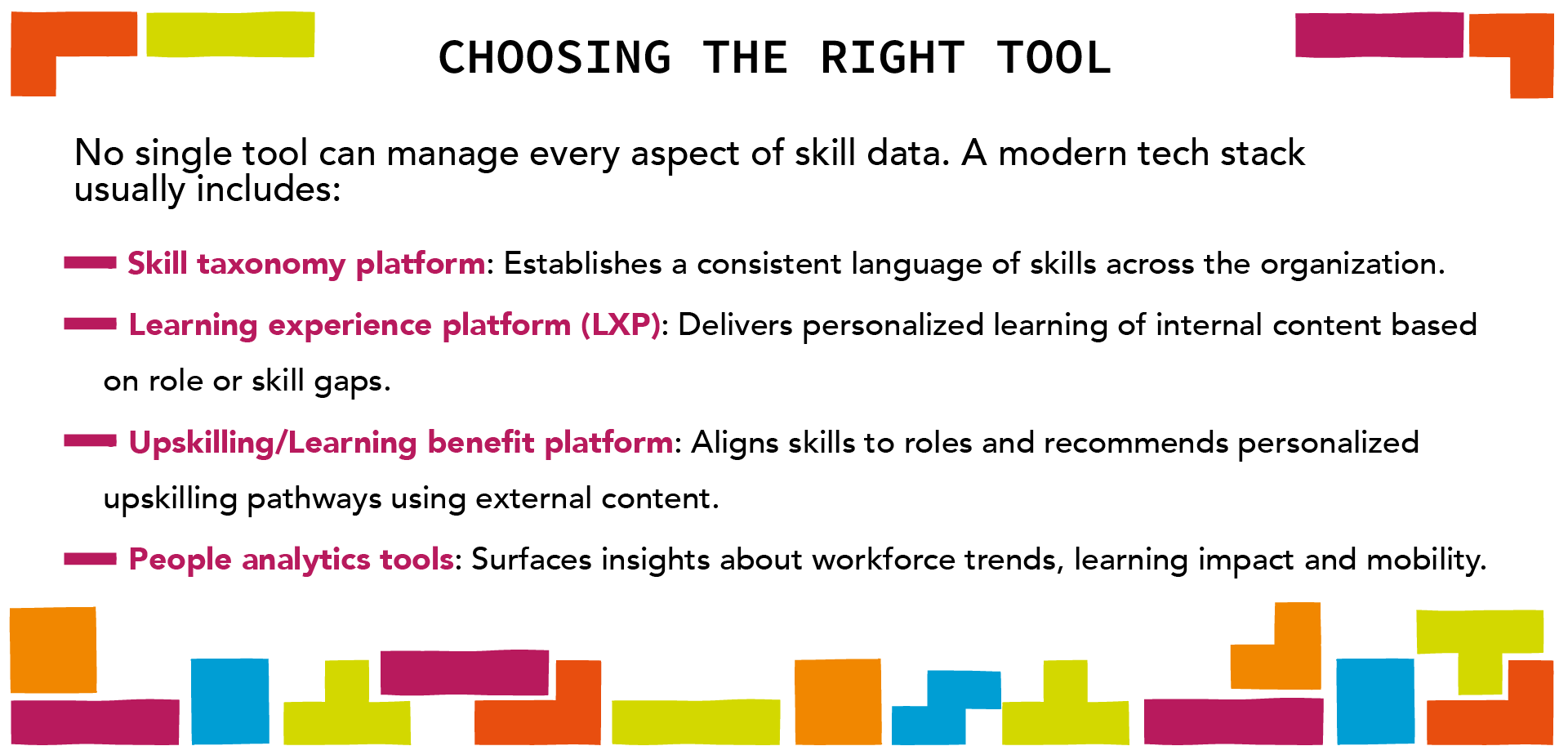

Published in Summer 2025
The types of skills that enable employees today are not the ones they’ll need tomorrow. Staying competitive requires a clear understanding of your organization’s current capabilities and the skills needed to get ahead. At the pace of technology change today, that’s a daunting task. Fortunately, you’re not operating in the dark; skill data offers insights into the capabilities of employees, enabling organizations to make informed decisions about talent development, learning programs and overall learning strategy.
This article explores how organizations can unlock the power of skill data to enhance learning and development (L&D) programs, refine strategies based on adoption data, measure the return on investment (ROI) of skill development initiatives and embed new insights into daily actions.
Identify Industry and Organizational Skill Needs
To make skill data actionable, you must first understand the current skill landscape within your organization and your industry. It can also be helpful to look for trends outside of your industry to gain insights that might apply to your own or spark creative thinking.
As an example, let’s look at digital skills, which research indicates are in demand across nearly all industries. According to the National Skills Coalition, 92% of jobs now require at least some digital skills, yet only one-third of workers analyzed had foundational digital skills needed to succeed. This research highlights a significant gap between employer expectations and the digital skills available in the labor market.
Another study from the Business-Higher Education Forum (BHEF) and Burning Glass Technologies analyzed more than 56 million resumes and 150 million unique U.S. job postings to identify essential skills for the digital economy. This research found that human skills such as critical thinking and communication, digital skills such as data analysis and software development, and business enabler skills such as project management and digital design are all in high demand as roles become more digital.
By conducting a thorough assessment of your organization’s current skill set and comparing it with industry benchmarks, you can identify gaps and make plans for development. This understanding will become the foundation of your targeted L&D strategy.
Align Learning Initiatives to Fill Gaps
Once you’ve identified skill gaps within your organization, the next step is to align your company’s learning programs to address those needs.
To effectively leverage the skill data you find:
- Map skills to roles: Identify the specific skills required for each role within your organization. This mapping will help you build targeted learning paths.
- Build personalized learning paths: Create customized learning programs that map to the individual needs of your employees, focusing on bridging those identified skill gaps.
- Choose platforms that provide data: Implement learning management systems that provide analytics on skill development progress. This will enable you to modify learning programs as needed.
- Encourage continuous learning: Foster a culture of continuous learning by providing employees with access to resources that promote skill enhancement. A learning culture includes elements such as dedicated time to engage in learning, reimbursement for training programs and manager encouragement.
Continuously Improve Through Data
To ensure the effectiveness of learning programs, it’s important to continuously monitor and refine them by leveraging adoption and performance data. According to the 2025 LinkedIn Workplace Learning Report, L&D professionals measure the business impact of career development programs through employee engagement, retention, promotions, internal mobility and other indicators.
Key strategies to refine learning programs include:
- Track engagement metrics: Monitor participation rates, completion rates and feedback to assess the relevance and effectiveness of learning content.
- Assess skill acquisition: Use assessments and evaluations to determine if employees are acquiring the skills you hoped they would. If you trust the content you use and training partners you work with, completion is also a good metric of skill attainment.
- Analyze performance outcomes: Evaluate the impact of skill development on job performance, productivity and business outcomes.
- Update content regularly: Regularly update learning materials to reflect changing standards and emerging skill requirements in your own industry.
When you dig into adoption data, you can make informed decisions to enhance the quality and impact of your learning programs.

Measure the ROI of Skills Development
Demonstrating the ROI of skills development initiatives is essential for securing continued broad company support and resources.
To measure ROI:
- Define clear objectives: Establish specific, measurable goals for learning programs, such as improving productivity, reducing turnover or enhancing customer satisfaction.
- Collect baseline data: Gather data on key performance indicators before implementing learning initiatives so that you can measure improvement.
- Monitor progress: Continuously track the progress of learning programs against established goals.
- Analyze outcomes: Assess the impact of skill development on business outcomes, considering factors such as increased efficiency, higher employee engagement and improved financial performance.
- Report findings: Communicate the results to stakeholders, and, if all is working according to plan, you’ll be able to clearly show the value derived from investing in skill development.
By systematically measuring ROI, organizations can demonstrate the tangible benefits of their learning programs and make data-driven decisions for future initiatives.
Operationalize Skill Data in Your Organization
Turning skill data into results isn’t just about having the right dashboards. It’s about embedding newfound insights into your daily decisions, aligning teams around shared goals and building feedback loops that evolve with you.
An effective skill data strategy requires shared ownership across teams. Here’s who should be involved — and what they should take on:
- HR/Talent management:
- Develop skill frameworks
- Integrate into performance reviews
- Oversee reskilling/upskilling strategy
- L&D teams:
- Map learning content to skill gaps
- Create learning pathways
- Track engagement and outcomes
- People analytics/HRIS:
- Maintain accurate skill data
- Build dashboards
- Deliver insights to stakeholders
- Business leaders/managers:
- Validate in-demand skills
- Identify team-level gaps
- Support application of learning on the job
- Employees:
- Self-assess skills
- Engage with learning content
- Apply skills to real work and career planning
If this seems too daunting to tackle on your own — you don’t have to. There are several platforms, tools and marketplaces that have sprung up in this space to help. The best choice for you will depend on your needs and skills sophistication, but look for a true partner who can fill the gaps you have — whether that’s in technology or in analytics.

Enable Behavior Change to Support a Skills-First Strategy
To truly turn skill data into action, you need to shift behaviors across the organization. That means aligning leaders, managers and employees around a shared purpose and creating systems that support new ways of working.
Here are a few practical guideposts to increase your chance of success:
- Executive champions: Find a partner in upskilling. Secure at least one senior leader who will communicate the value of skill development regularly.
- Manager toolkits: Equip managers with talking points and data reports to support their skill-supporting conversations.
- Internal communications campaigns: Brand your upskilling initiative with a recognizable name and story. Keep updates regular and clear.
- Reward and recognize: Celebrate teams or individuals who hit skill milestones or apply learning to create business value.
The more you treat skills as a shared currency across your organization, the easier it becomes to align learning with growth — and your people with newly skilled purpose.
Incorporating skill data into organizational strategies enables businesses to proactively address skill gaps, align learning programs with strategic objectives, refine initiatives based on data insights and measure the impact of skill development efforts. Organizations that use skill data effectively build a resilient, adaptable workforce capable of thriving in an ever-changing business environment.